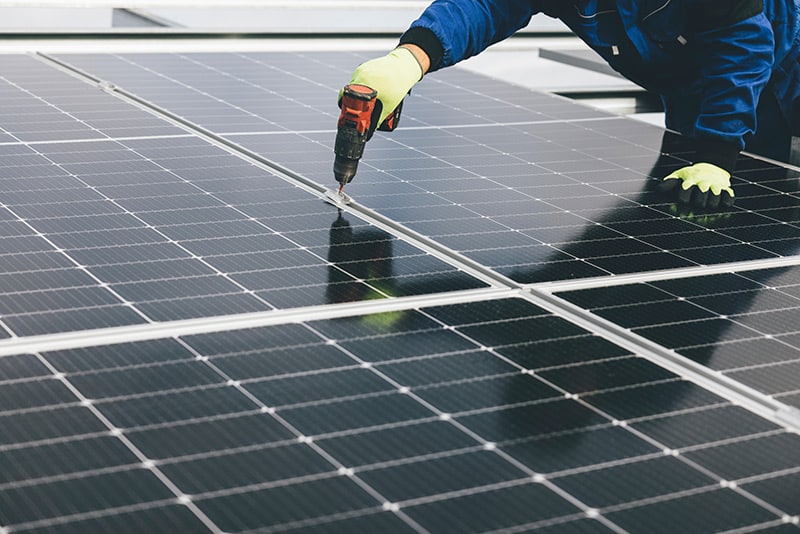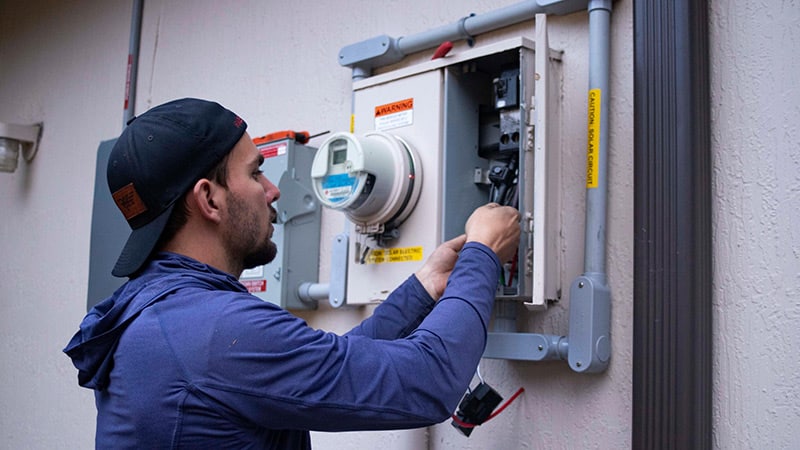Does asbestos affect solar panel installation?
It shouldn’t be a great surprise that in recent years, so many property owners have looked seriously at the notion of having solar electricity panels, also known as solar photovoltaic (PV) panels, installed at their buildings.
Energy from the sun is, after all, free, and the ability to generate one’s own electricity – while cutting energy bills – can be a major advantage. This is before one even considers the status of solar energy as a renewable, low-carbon source of energy that can greatly help reduce an individual or business’s carbon footprint. A typical home solar PV panel installation could save approximately one tonne of carbon a year, depending on the property’s location in the UK.
However, not everyone is necessarily alert to the potential connection between solar panel installation and asbestos. With it being crucial to ensure safe and sustainable installation practices in the renewable energy sector, we have below explored what that connection is, and what you may need to do accordingly as the owner or dutyholder for a property where solar panels may be installed.
Asbestos and solar panel installation
The most obvious link that can be made between solar panel installation and asbestos, is with regard to the possible fitting of such panels on a roof that contains asbestos.
Asbestos was once an extensively used construction material in the UK, and was commonly used in roofs from around the 1930s until the 1980s. Garages, sheds, and farm buildings that were constructed or refurbished during that period are especially likely candidates to contain asbestos in their roofs.
It took until late 1999 for all forms of asbestos to finally be banned in the UK. This outlawing of the material’s importation and use was in light of the extremely serious health risks that were found to be associated with it. When someone ingests or breathes in asbestos, they can be at elevated risk of developing an asbestos-related disease such as mesothelioma, asbestosis, or asbestos-related lung cancer, potentially decades after they were exposed to the substance.
Although the use of asbestos in construction projects was banned in 1999, there has never been a legal obligation to remove asbestos from any and all UK buildings in which it is already present.
This means that if your own property has an asbestos roof, or contains asbestos in some other way, it is of the utmost importance to ensure the responsible management of the material, to protect the safety of both solar panel installers and the regular building occupants and users.
Surveying for asbestos
As we have explained previously here at Oracle Solutions, it is effectively a legal requirement for any commercial property built before the year 2000 to hold an asbestos survey. Indeed, if you already own or control a non-domestic property that dates from this period, there should already be some form of valid asbestos survey or asbestos register for it.
As for if you are looking to have solar panels fitted at a domestic property such as your own home, there is not the same legal requirement to hold asbestos-related information for it.
However, by arranging to have an accredited asbestos surveyor carry out a thorough asbestos survey of your property – irrespective of whether you are legally compelled to do so – you can greatly help to protect not only any solar panel installers who may work on your property, but also everyone who uses the building on a regular basis.
Types of asbestos-containing materials (ACMs)
Although we have particularly emphasised roofing in this article, there is a wide range of products that were used in UK construction until the 1999 ban, and which remain present in great numbers of properties up and down the country today.
Examples of ACMs that could therefore conceivably be disturbed by the activities of a solar panel installer, include the likes of:
- Roofing felt
- Loose asbestos in ceiling and wall cavities
- Sprayed coatings on ceilings, walls, and beams/columns
- Floor tiles, textiles, and composites
- Textured coatings
- Asbestos insulating board (AIB)
The installation of solar panels on a roof is an example of activity that can disturb any ACMs that may be present within the roof. Such disturbance could result in the release of potentially dangerous asbestos fibres.
So, while it is possible to fit solar panels to a roof even if it is an asbestos one, the advisable course of action is to ensure remedial work is carried out first, to guard against any risks.
Managing asbestos risks
When it comes to managing the risks that asbestos could present during solar panel installation, it is important to be mindful of any obligations that you might have under the Control of Asbestos Regulations 2012 (CAR 2012).
This legislation is aimed at those who manage non-domestic premises. It puts in place certain requirements for “dutyholders”, including to take reasonable steps to determine what the asbestos situation is in the property for which they are responsible.
Whether or not you are specifically subject to these regulations – they are, as we stated above, directed at those managing non-domestic buildings – you should still be taking the necessary steps to ensure any ACMs in your property have been identified and recorded, before you commit to solar panel installation.
Knowing this information about any ACMs on the site – including in relation to their exact location, amount, and condition – will greatly assist you in the implementation of safe work practices to prevent disturbance. The provision of proper training and personal protective equipment (PPE) for anyone working on the building, will also be crucial for managing asbestos risks.
As for what exactly you might do to the asbestos itself in order to manage such risk, this will depend on the exact information uncovered through the surveying process.
In the case of the potential installation of solar panels on an asbestos roof, you might choose to have your roof overclad with steel, for example. This would provide a shield of protection for solar panel installers, and would have the further benefit of making your roof more insulated.
Staying with the roof example, it might also be possible that you decide to have your existing asbestos roof entirely removed, and replaced with a new corrugated steel roof. This can be a very expensive course of action, but it would eliminate the asbestos risk, in addition to giving you a long-lasting and well-insulated new roof on which solar PV panels could be safely installed.
When asbestos removal is necessary
Depending on such factors as the location, condition, and amount of asbestos that you discover in your property as a result of the asbestos survey, and the risk of these ACMs being disturbed, you might conclude that you can leave the ACMs in place without it posing a discernible risk.
However, when it comes to a process as potentially intrusive as solar panel installation, you will need to be alert to the possibility of complete removal of the asbestos being required.
You may reach this judgement, for example, if the asbestos is old and in poor condition, as well as if it is in a location that would present a high risk of a solar panel installer (or someone else in the building) causing disturbance to it.
If you do conclude that it is essential to have the given asbestos removed from the building, the hiring of asbestos removal professionals who are licensed by the UK Health and Safety Executive (HSE) will enable you to be utterly confident of the thoroughness and safety of the removal work carried out.
The asbestos removal process
Once you have determined information about the location, condition, and amount of asbestos in your property, and have decided that the risks posed by the ACMs necessitate their removal, you can expect your chosen asbestos removal contractor to follow these broad steps:
- Ensuring the asbestos materials are contained to minimise the risk of any fibre release and spread during the removal process
- The safe and complete removal of the asbestos materials
- The safe and legal disposal of the removed ACMs, which should be proved by the issuing of a hazardous waste note and a clean air certificate
- The complete cleanup of the affected area, so that solar PV installers can proceed with their work in the knowledge that no risks have been created or left behind.
Strict regulations now exist in the UK in relation to the management of asbestos, including with regard to asbestos removal works. By placing your trust in asbestos removal professionals who are fully licensed by the HSE for all types of asbestos removal, repair, and remediation, you can be sure that all the responsible and legally compliant processes will be followed.
Safe solar panel installation
With solar panel installation typically being a job that is carried out in the open air, this further underlines the importance of responsible asbestos management on the given site – not just to protect the health of those immediately nearby, but also to do the right thing for the wider environment.
If you have an asbestos cement roof at your property and it is in very good condition, you may decide that the roof does not need to be removed, and that the solar panels can therefore be installed on it. In the event that you do reach this conclusion, you will need to be mindful that the process of attaching the solar panels will necessitate a certain amount of drilling into the asbestos material.
Although the drilling of asbestos is not recommended if it can at all be avoided, it is possible to carry out this operation safely, provided that it is undertaken by suitably competent and trained people, and the correct control measures are in place.
Drilling through asbestos cement is considered a “non-licensed” activity – in other words, one for which a licence from the UK Health and Safety Executive (HSE) is not required. However, it is still a task for which the use of a licensed contractor’s services is recommended, given that the act of drilling asbestos can generate potentially dangerous loose asbestos dust.
After all, a licensed asbestos contractor will possess the experience, training materials, equipment, and insurance that will be required in order to carry out this work safely. Such an asbestos contractor will know of the importance of only drilling asbestos cement slowly and gently, as a means of reducing the risk of asbestos dust being generated.
A licensed asbestos professional will also be highly familiar with the other steps that can help minimise risk during this work. Those will include wearing appropriate personal protective equipment (PPE), using tools that are designed to minimise the creation of dust and debris, and ensuring roof tiles are wetted first – the latter a measure that will help keep asbestos fibres in place, preventing them from becoming airborne.
Having said all the above, it is also important to ask yourself whether drilling into asbestos materials is truly necessary. Even when the greatest care is taken, drilling into an asbestos cement roof can be a risky operation, and there might be a safer part of the building where solar panels can be installed.
Whether any given asbestos in your building is removed altogether, or instead left in place, monitored, and managed, when you take steps like those outlined above, you will be helping to “futureproof” your property and how occupants use it, at the same time as ensuring the greatest possible safety for everyone.
Conclusion: don’t overlook the risks asbestos can pose if you are considering solar panel installation
In this article, we have sought to make clear how important it is to be vigilant about the possible asbestos risks in a property for which you are responsible, including when you are seeking to have solar panels installed at your site.
Although the most obvious connection between solar PV installation and asbestos may be the risks that asbestos roofing could present, you should also be alert to the various other ACMs that may be contained within your property, and the possible implications for anyone working on your premises.
By working to ensure the utmost safety, compliance, and sustainability in your solar panel installations at any domestic, commercial, or public sites for which you are responsible – especially for buildings dating from before the year 2000 – you will be greatly helping to protect not only yourself, but also anyone else who may occupy or work in your property.
Request an asbestos quote from the Oracle Solutions team today, to discover more about the excellent value our nationwide, licensed, and accredited asbestos management services could represent for you.

Written by Callum McDonald
Callum McDonald is an expert in asbestos quality management, ensuring rigorous adherence to regulations and high-quality standards in removal projects. His focus on enhancing quality and client satisfaction makes him a crucial asset in safety and compliance within the field. Callum's expertise in technical support and oversight of licensed works underscores his commitment to excellence in asbestos management, providing invaluable guidance to clients in this specialised area.


